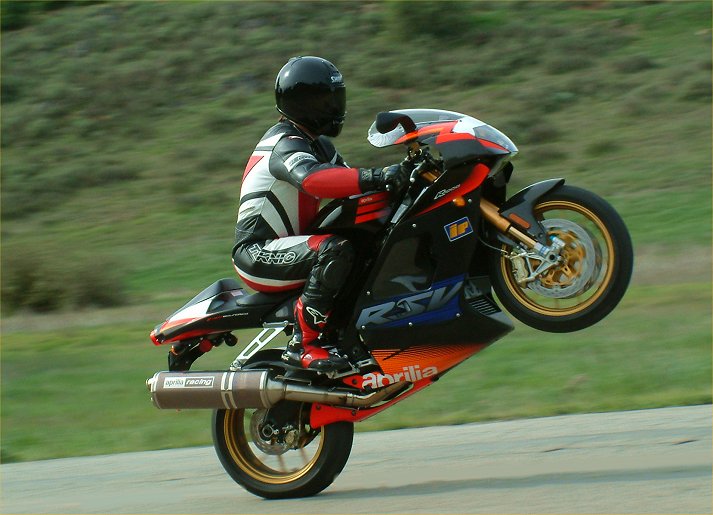
When the press and enthusiasts became aware that Aprilia was developing a 1000cc v-twin superbike in the late 90s, a good deal of excitement was generated. After all, Aprilia was the “giant killer” of GP roadracing, having won multiple championships in both the 125cc and 250cc classes. Having developed riders like Max Biaggi and Valentino Rossi, Aprilia had impeccable racing credentials, but those credentials related to relatively small-displacement two-strokes. Could Aprilia build a competitive, large-displacement four-stroke superbike in its first effort?
Contracting out some of the engine development work to Rotax, as well as ultimate manufacture of the compact, sixty degree v-twin, Aprilia’s engineers applied their extensive racing experience to chassis design. When the Mille first appeared, it was an instant hit. Nipping at Ducati’s heels with its first effort, Aprilia won over the press and, more importantly, a customer base for its road-going superbike.
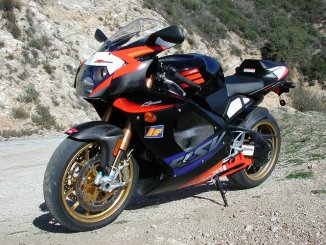
Like the relatively small, entrepreneurial manufacturer that it is, Aprilia proved quick on its feet, as well. Just a couple of years into the Mille’s life span, Aprilia made significant changes. Indeed, the 2001 model had over 200 changes, some of them very subtle (including, raising the engine height in the frame 5mm — in order to line it up more closely with the roll axis of the bike). Aprilia meant business with the Mille, and the 2001 model was a significant step forward from its already impressive start with the 1999 model.
Fast forward to 2003. In perhaps the last year of this basic design, Aprilia continues to tweak and refine the Mille. We spent a couple of weeks riding a Mille R (the higher spec version with Ohlins suspension, forged aluminum wheels, lots of carbon fiber body parts, etc.) here on the streets and through the canyons of Southern California. Before we get to our riding experience, let’s discuss the changes to the 2003 MIlle R model.
For 2003, the Mille R features radially mounted brake calipers for the first time. Take a look at our November 13, 2002 article on this brake technology developed in racing that is now emerging on street machines. In summary, the radial mounting of the brake calipers reduces caliper flex and increases brake performance. It also allows for smaller diameter brake rotors, which reduces the gyroscopic effect of those rotors on the front wheel (permitting quicker turn-in, for instance). The fact that the Mille R has top-notch Brembo radial-mount brakes, yet still employs huge, 320mm discs, promises massive braking power.
Another significant change for 2003 involves the gearbox. A new, close-ratio, six-speed transmission (first through third gears are taller) assures you stay “on the pipe” when shifting up through the gears (not generally a problem with this motor, in any event, as we will discuss below).
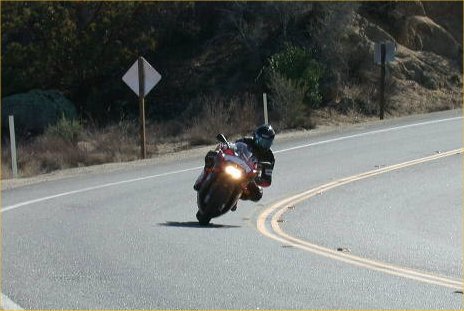
There are other, less significant changes, as well, such as a new fork design, new front wheel design, matte black painted frame, new tail design, new front fender design, etc.
Since we only rode the Mille on the street, this isn’t intended to be a track test. Aprilia’s racing credentials speak for themselves, however, and Troy Corser, Noriyuki Haga and others have amply demonstrated the on-track capabilities of Aprilia’s superbike design. This is about living with the Mille R in the real world.
Let’s face it, a bike like the Mille R is not for commuting to work. It is a stallion. You polish it, stare at it in your garage for countless hours, and ride it for pleasure. You also use it to measure and expand your own riding abilities . . . the same way you would measure and expand your driving abilities if you owned a Ferrari or Porsche.
The Mille R is more a work of art than a transportation device. It is intended to be Aprilia’s ultimate expression of its engineering and racing experience, with street-legal lights and emissions equipment added on as an afterthought.
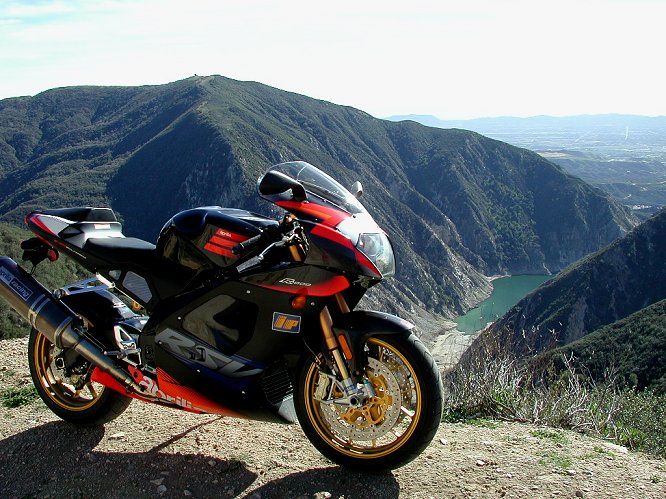
A stallion it is, but the 2003 Aprilia Mille R is an extremely well-trained stallion. When you ride the bike, it is predictable and, at the same time, highly responsive to your inputs.
The engine is powerful, but also features a wide powerband that never surprises you. Coming on strong at relatively low revs, the engine is precisely metered by a fuel injection system with virtually perfect mapping. Off/on throttle transitions are as good as we have ever experienced in a production motorcycle. Not surprisingly, Aprilia worked hard to make sure that throttle inputs are smooth and subtle, because the Mille is intended to occupy considerable time at major lean angles where abrupt throttle transitions would put the rider in a precarious situation (such as flying through the air after a high side).
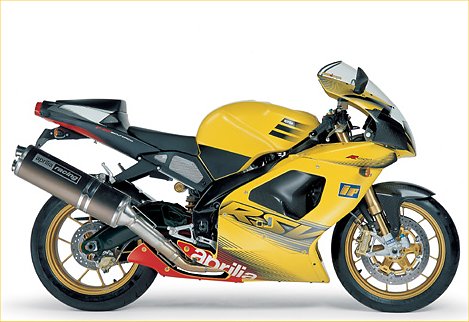
The chassis does its part, too. Although the expected, aggressive ergonomics (but comfortable enough for dedicated sport riders) place a fair amount of weight on your wrists while droning along on the freeway, the riding position weights the front wheel in a manner conducive to aggressive sport riding (or racing). The sculpted fuel tank allows you to grip the bike around its narrow waist, and really feel a part of the machine while riding it. Aprilia has carefully revised the fuel tank shape (lower and narrower), for instance, so as not to interfere with the rider’s private parts during this intimate rider/machine relationship.
The fully adjustable (compression, rebound and preload) Ohlins fork and shock move through their stroke as smooth as a hot knife through butter. Moreover, the valving characteristics of the fork, in particular, are superb. An overly-stiff shock spring prevented us from fully understanding the potential of the rear suspension during our ride, but some tweaking created a better balance between front and rear.
The Mille R lives for corners . . . corners of all types. Aided by the extremely light forged aluminum wheels (and careful mass centralization — remember that 5mm engine repositioning in 2001?), the Mille R changes directions with very little effort. Compared to the Honda RC51 we tested last year, the Mille R transitions from side-to-side like a much smaller bike. There is no trade off with stability, either, as the Mille R tracks exactly where you intend it to — even with your ear on the ground.
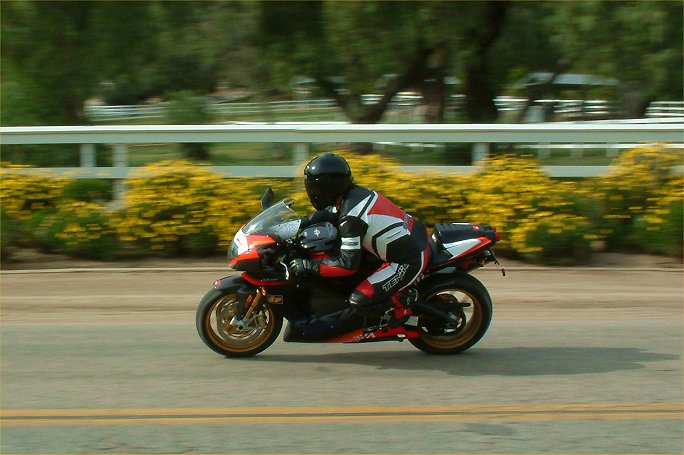
In fact, it is the level of confidence the Mille R gives you in corners that summarizes what this bike is all about on the street. Those big power pulses from the v-twin could be a handful on most corner entries and exits, but Aprilia, once again, has carefully engineered around this. On corner entry, engine braking is very well controlled by the slipper clutch mechanism, which allows you to bang downshifts without as much concern for rear wheel hop or lock up.
Getting on the power while exiting corners is just as smooth and predictable. That precise fuel injection system we discussed earlier lets you roll on the power early, with a still-deep lean angle, all without drama or worry.
The redesigned six-speed transmission worked well during our test. Smooth enough, and precise, we never missed a shift, and clutchless up-shifts are a piece of cake.
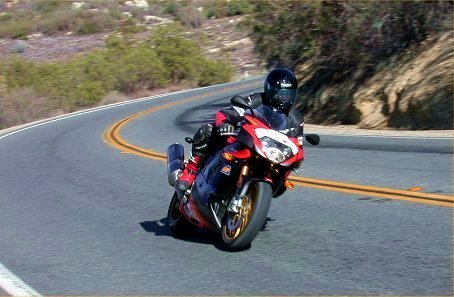
Those radial brakes took a while to reach their prime (our test unit had very few miles on it, at first). After everything bedded in, the front brake was enormously powerful, but retained good feel and modulation. An initial feeling of imprecision at the front brake lever (a too-sudden response following about one-half inch of lever travel) seemed to cure itself as we put more miles on the bike. In the end, we felt we could stand the Aprilia on its nose whenever we felt like it. The rear brake (less of a concern for racers and most of you aggressive street riders) plays its limited role well, with enough power and, more importantly, progressivity (too much rear brake is a bad thing in a bike like the Mille R).
Wind protection is relatively minimal, reflecting the nature of the beast, but still a bit better than most of the competition. The wind blast coming off the screen creates a smooth, buffet-free flow of air at helmet level.
By sportbike standards, the seat isn’t too bad either. Extended freeway commutes to and from the MD offices were possible without undue pain or discomfort. Vibration levels are low enough so as not to annoy the rider, yet the rider always knows that big v-twin heart is beating beneath him (or her).
We would like to have tried a different shock spring, as we never felt a perfect balance between the front and rear suspension during our brief test. Aside from that and the stock Pirelli tires that never seemed to reach optimal operating temperatures on the street (they are probably better suited for the track), we are hard pressed to criticize the Mille R. It is what Aprilia intends it to be, i.e., a highly refined and developed race bike for the street. It’s moves are quick, but precise and controlled. It’s engine is powerful, but smooth and predictable. It’s aesthetics are Italian . . . generally, a good thing, and certainly a good thing in the case of the Mille R.
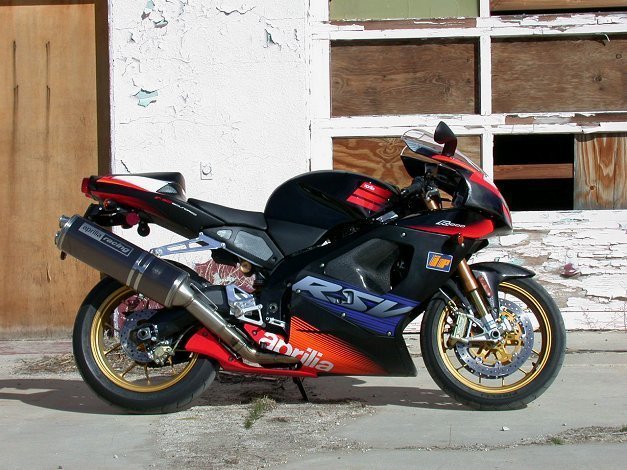
Could the 2003 Aprilia Mille R be a bargain on top of all this? A bargain at a suggested list price of $17,299? We think so, and here is why. For your money, you get a beautifully designed Italian racing machine (just look at that curved swingarm, superbly executed carbon fiber body pieces, and countless other details), top-drawer Ohlins suspension components and Brembo brake components, and more street cred than you need or deserve. Put these same suspension components, brakes and those forged aluminum wheels on any other bike, and then add up what you have paid for it. We did this mental exercise, ourselves, and came away impressed with the Mille R’s price.
Of course, not everyone can afford a Mille R, but for those who can and are looking for the type of street riding experience it offers, go get your checkbook and don’t look back.
Take a look at Aprilia’s web site for additional details and specifications.





